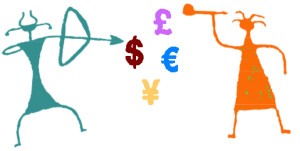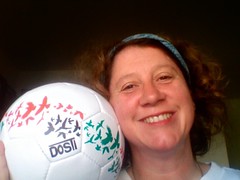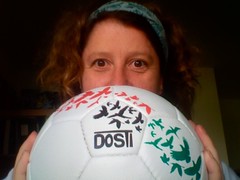 Here are two questions regarding volunteer engagement I am seeing a lot through various channels… but not seeing many answers to:
Here are two questions regarding volunteer engagement I am seeing a lot through various channels… but not seeing many answers to:
Where can young children – children under 13, even as young as 6 – volunteer? What kinds of activities can they do and exactly where can they do these?
and
Where can people with diminishing mental abilities, or with mental disabilities, volunteer? What kinds of activities can they do and exactly where can they do these?
The first set of questions come from parents, as well as children under 13, on various online discussion groups, like YahooAnswers.
The second set of questions come primarily from volunteer managers – from those in charge of recruiting and involving volunteers at an organization – and are often the result of a long-time, beloved volunteer becoming less and less capable of helping, and requiring so much supervision and assistance that the organization feels the benefits of involving the volunteer are far below the costs. Or, that volunteer becoming verbally abusive, or saying inappropriate things to other volunteers, as a result of their diminished mental capabilities. But I’ve also seen the question asked by siblings, parents and other caretakers of people with mental disabilities.
I’m very disappointed not to see organizations that are supposed to have the promotion of volunteerism as the central focus of their mandate jumping in to answer these questions. Where are you, Points of Light Foundation? Hands On Network? Why aren’t you out there on various online fora, such as YahooAnswers, addressing these tough questions about volunteering?
Anyway…
I’m not at equating children and people with diminished mental capacities. These are two VERY different groups. But they do have one thing in common: they require much more planning, support and staff time to involve than adult volunteers. Hence why I’m discussing these two groups at once here in this blog.
The reality is that it’s more efficient, economical and immediately beneficial for most nonprofit organizations, non-governmental organizations (NGOs) and charities to involve adult individual volunteers who can successfully complete a project, from start to finish, with minimum supervision. Also, most organizations do not have the money, staff, time and other resources to create volunteering opportunities focused primarily on fulfilling the needs of various types of volunteers, rather than creating volunteering activities that are focused primarily on fulfilling the needs of an organization (I’ve said this about microvolunteering as well!). For most organizations, volunteer engagement is primarily about fulfilling the organization’s mission, not fulfilling the wishes of volunteers.
If you think nonprofits, NGOs, charities and others should involve everyone who wants to volunteer, no matter the volunteers’ ages or abilities, then consider this: no matter what your job is, no matter what sector you work in (for-profit, government, nonprofit, whatever), could YOU come up with a safe, fun, meaningful hour-long activity for a 10 year old child to do in your office twice a week, or a two-hour weekly activity for a dozen 10 year olds to do in your office, and do you have time to supervise that child or those children during that activity? What about creating similar activities for someone who has severe short-term memory loss? If you could not do it in your own job at such-and-such corporation, why do you expect nonprofit organizations to do so?
Just as creating one-time, short-term group volunteering activities for adults is difficult, creating volunteering opportunities for children, or for people with diminished or diminishing mental abilities, is also difficult. Should a nonprofit, NGO or charity be spending time and resources to involve these groups? In some circumstances, yes.
First, think carefully about what is in it for you, the organization or program, to create opportunities for either of these groups. What benefit are you looking for?:
- measurable results regarding participant or community awareness of a particular issue, program or your organization. Could the volunteering activity help children understand a particular issue? Could the activity help parents or family issues understand the issue more fully?
- cultivation of donors who would be interested in funding this part of your organization’s program. The staff time to create opportunities and support these volunteers, the materials needed by volunteers, etc. all need funding. Are there foundations, corporate philanthropy programs, government agencies or individual donors who would be attracted to funding the resources required?
- activities that fulfill your organization’s mission. The volunteering experience results in activities that reach part of your organization’s mission. For instance, if you work with seniors, particularly those with diminished mental faculties, then involving these seniors as volunteers would be a part of your mission. If your organization is focused on children under 13, then involving those children as volunteers would be a part of your mission.
I wrote a page on creating one-time, short-term group volunteering activities, and it includes a long list of activity suggestions. Some of those could be adapted as volunteering activities for children, or for people with very limited mental capacities – but not all of them. And to be honest, I’m stumped on creating voluntering activities for either of these groups.
Not every organization is going to be able to address any of those three bullet points – and, therefore, is not going to be in a position to create volunteering opportunities for either of these special needs groups. What I advise those organizations to do:
- For those that are getting called by parents who want their children to volunteer, have a list of other organizations in your area to refer their child to. For instance, for girls, I recommend the Girl Scouts of the USA (or, in other countries, Girl Guides). I also have a web page of recommendations for family volunteering – specifically families that include children under 16 – note that many activities are home-based.
- For those that ask about volunteers with diminished mental capacities – for instance, an organization that finds a long-term volunteer can no longer undertake any of the volunteering opportunities at the organization, could a placement be found elsewhere? Is there a community theater that could involve him or her to hand out programs before a performance? Could the volunteer help serve refreshments at an event – just putting cups filled with a liquid, not doing any of the fillings of the cups him or herself? And does the family of this person understand that a family member will have to be with the volunteer at all times? Or is there an organization in your community that helps people with diminishing mental capacities that you could introduce the volunteer to, that could give that person meaningful activities to engage in – like going to community events in a group? Does this volunteer attend events by a community of faith (a church, temple, mosque, etc.), and could that community be called on to help in this situation?
What other advice do you have for parents seeking volunteering activities for young children, or nonprofit organizations that are going to have to let a volunteer go because of diminished mental capabilities? Leave your answers in the comments. What I’m particularly interested in: how did you go about letting a long-time volunteer go that you had to let go because of his or her diminished mental capabilties, and what did you learn from that expereince that you would like to share with others?
Also see:
Creating one-time, short-term group volunteering activities
Recommendations for family volunteering – specifically families that include children under 16
 Some of the most frequently asked questions (FAQs) to online forums for community-based organizations (CBOs) in developing countries, whatever the subject, are regarding funding.
Some of the most frequently asked questions (FAQs) to online forums for community-based organizations (CBOs) in developing countries, whatever the subject, are regarding funding.


 Kudos to the
Kudos to the 